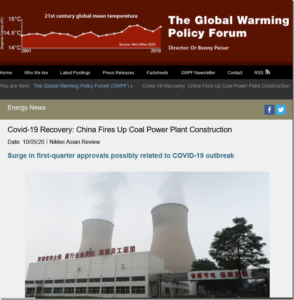by J. Curry, January 3, 2018 in ClimateEtc.
Short summary: scientists sought political relevance and allowed policy makers to put a big thumb on the scale of the scientific assessment of the attribution of climate change.
Bernie Lewin has written an important new book:
SEARCHING FOR THE CATASTROPHE SIGNAL:The Origins of The Intergovernmental Panel on Climate Change
The importance of this book is reflected in its acknowledgements, in context of assistance and contributions from early leaders and participants in the IPCC:
This book would not have been possible without the documents obtained via Mike MacCracken and John Zillman. Their abiding interest in a true and accurate presentation of the facts prevented my research from being led astray. Many of those who participated in the events here described gave generously of their time in responding to my enquiries, they include Ben Santer, Tim Barnett, Tom Wigley, John Houghton, Fred Singer, John Mitchell, Pat Michaels . . . and many more.
You may recall a previous Climate Etc. post Consensus by Exhaustion, on Lewin’s 5 part series on Madrid 1995: The last day of climate science.
Read the whole book, it is well worth reading. The focus of my summary of the book is on Chapters 8-16 in context of the theme of ‘detection and attribution’, ‘policy cart in front of the scientific horse’ and ‘manufacturing consensus’. Annotated excerpts from the book are provided below.
…
by P. Homewood, May 10, 2020 in NotaLotofPeopleKnowThat
China approved nearly 10 gigawatts of new coal-fired power generation projects in the first quarter, roughly equal to the amount approved for all of last year, amid a broader scramble to jump-start an economy hobbled by the COVID-19 epidemic.
Investment in infrastructure like power generation has played an important part in China’s rapid economic rise, especially in times of economic distress like the global financial crisis of 2008 and 2009. Many expect such spending to play an important role as Beijing tries to restart the economy in the aftermath of the coronavirus outbreak that has brought activity to a crawl, causing the economy to post its first quarterly contraction since modern record-keeping began.
Coal has always been a controversial part of the nation’s power mix. On the one hand, China has plentiful supply of the resource, which it has harnessed to rapidly build up power infrastructure to feed the country’s growing economy. But such energy is notoriously dirty, and overly aggressive building led to oversupply earlier this decade that sent many producers into the red.
Those factors led the government to scale back and even halt many new coal-powered projects in recent years. But that trend went into reverse in the first quarter, when six major new coal-fired projects were approved that could add 9.96 GW of capacity, according to calculations by Caixin.
That was roughly equal to the amount of similar new power projects approved for all of last year. Of the new projects, four were in the coal-rich area of Shaanxi province, one was in South China’s Guangdong Province and one was in Inner Mongolia.

…
by University of California Davis, May 6, 2020 in WUWT
The lightness of water vapor buffers climate warming in the tropics.
Conventional knowledge has it that warm air rises while cold air sinks. But a study from the University of California, Davis, found that in the tropical atmosphere, cold air rises due to an overlooked effect — the lightness of water vapor. This effect helps to stabilize tropical climates and buffer some of the impacts of a warming climate.
The study, published today (May 6, 2020) in the journal Science Advances, is among the first to show the profound implications water vapor buoyancy has on Earth’s climate and energy balance.
Abstract
Moist air is lighter than dry air at the same temperature, pressure, and volume because the molecular weight of water is less than that of dry air. We call this the vapor buoyancy effect. Although this effect is well documented, its impact on Earth’s climate has been overlooked. Here, we show that the lightness of water vapor helps to stabilize tropical climate by increasing the outgoing longwave radiation (OLR). In the tropical atmosphere, buoyancy is horizontally uniform. Then, the vapor buoyancy in the moist regions must be balanced by warmer temperatures in the dry regions of the tropical atmosphere. These higher temperatures increase tropical OLR. This radiative effect increases with warming, leading to a negative climate feedback. At a near present-day surface temperature, vapor buoyancy is responsible for a radiative effect of 1 W/m2 and a negative climate feedback of about 0.15 W/m2 per kelvin.
by RA. Pielke and R. Avissar, 1990 in LandscapeEcology
Abstract
This paper discusses the physical linkage between the surface and the atmosphere, and demonstrates how even slight changes in surface conditions can have a pronounced effect on weather and climate. Observational and modeling evidence are presented to demonstrate the influence of landscape type on the overlying atmospheric conditions. The albedo, and the fractional partitioning of atmospheric turbulent heat flux into sensible and latent fluxes is shown to be particularly important in directly affecting local and regional weather and climate. It is concluded that adequate assessment of global climate and climate change cannot be achieved unless mesoscale landscape characteristics and their changes over time can be accurately determined.
by Anthony Watts, May 1, 2020 in WUWT
UPDATE: Changed emphasis from Northern Hemisphere extratropics to entire Northern Hemisphere (h/t John Christy)
In April, 2020, the Northern Hemisphere experienced its 2nd largest 2-month drop in temperature in the 497-month satellite record.
The Version 6.0 global average lower tropospheric temperature (LT) anomaly for April, 2020 was +0.38 deg. C, down from the March, 2020 value of +0.48 deg. C.
The Northern Hemisphere temperature anomaly fell from +0.96 deg. C to 0.43 deg. C from February to April, a 0.53 deg. C drop which is the 2nd largest 2-month drop in the 497-month satellite record. The largest 2-month drop was -0.69 deg. C from December 1987 to February 1988.
…
by P. Dockrill, May 12, 2020 in ScienceAlert
The oldest bones of Homo sapiens ever found in Europe have been discovered in a Bulgarian cave, providing the earliest known evidence of our species’ emergence in the European continent, according to new research.
The appearance and spread of modern humans in Europe is a difficult timeline for researchers to reconstruct, owing to a scarcity of sufficiently ancient remains that have been identified in the fossil record.
When modern humans did show up, though, our arrival ultimately sealed the fate of the indigenous Neanderthals who called Europe home before us, as we then proceeded to swiftly replace them over the course of the next several thousand years.

…
La géologie, une science plus que passionnante … et diverse


